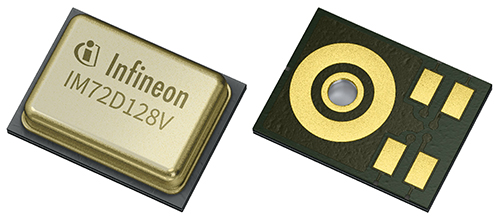Infineon Technologies recently expands its XENSIV ™ The MEMS microphone product line has launched two digital PDM microphones, IM72D128V and IM69D129F. The new product is based on Infineon's Sealed Double Diaphragm (SDM) technology, achieving IP57 level dust and water resistance while balancing high sound quality, low power consumption, and strong robustness. Among them, the IM72D128V has a signal-to-noise ratio of up to 71.5 dB (A), specially designed for precise pickup in low-noise environments; The IM69D129F, with its ultra compact size of 3.5 × 2.65 × 0.98 mm ³, is suitable for portable devices with extremely limited space. Both achieve digital signal output through low-noise preamplifiers and Sigma Delta ADCs, providing reliable audio solutions for consumer electronics, industrial monitoring, and vehicle systems.

1、 Technical difficulties and innovative solutions
In the development of high-end audio devices, MEMS microphones need to address three major challenges: balancing small size with high performance, withstanding complex environments, and synchronizing multiple device integration
The contradiction between space and performance: miniaturization of devices requires microphones to maintain a high signal-to-noise ratio within a limited volume. Infineon optimizes the diaphragm structure through SDM technology, achieving a signal-to-noise ratio of 71.5 dB (A) in IM72D128V, while controlling the size within 4 × 3 × 1.2 mm ³; IM69D129F further compresses its volume through 3D stacking packaging, while maintaining a signal-to-noise ratio of 69 dB (A).
● Improved environmental reliability: Dust and moisture can easily cause traditional microphones to fail. SDM technology blocks the intrusion of pollutants through a sealed chamber design, supports IP57 protection (can soak in 1 meter of water for 30 minutes), and ensures industrial grade durability through wide temperature testing (-40 ° C to+85 ° C).
Multi microphone array synchronization: In active noise cancellation (ANC) and other scenarios, phase consistency is crucial. The new product ensures multi microphone time delay alignment with a sensitivity tolerance of ± 1 dB and a flat frequency response of 11 Hz, combined with PDM interface to simplify system integration.
2、 Product Core Features
IM72D128V and IM69D129F demonstrate outstanding performance in electrical parameters, energy efficiency, and reliability
● Electrical performance:
IM72D128V: signal-to-noise ratio of 71.5 dB (A), power consumption of 430 µ A (high performance)/160 µ A (low power consumption), frequency response of 11 Hz-10 kHz.
●IM69D129F: signal-to-noise ratio of 69 dB (A), power consumption of 450 µ A (high performance)/170 µ A (low power consumption), size of 3.5 × 2.65 × 0.98 mm ³ (currently one of the smallest in the industry).
● System integration advantages: Built in low-noise preamplifier and Sigma Delta ADC, outputting digital PDM signals; Support dual power mode to extend the battery life of portable devices.
Compliance and reliability: Compliant with IEC 60747/60749 and JEDEC 47/20/22 standards, passed accelerated stress tests such as vibration and thermal cycling.
3、 Comparison of Competitors and Market Positioning
● Performance differentiation: IM72D128V surpasses Lou's IA8201 (65 dB) with a signal-to-noise ratio of 71.5 dB, making it particularly suitable for low-noise scenarios such as high-end headphones; The ultra small size of IM69D129F provides an alternative solution for space limited devices such as TWS earplugs.
●Comparison of technical routes: Lou focuses on integrating AI algorithms (such as adaptive noise reduction), while Infineon emphasizes hardware level reliability (such as IP57 protection), which is more suitable for harsh environments such as industrial and automotive environments.
●Market positioning: Infineon's new products cover consumer electronics (headphones, laptops) and industrial applications (security, automation), with a combination of "high signal-to-noise ratio+environmental robustness", benchmarking Lou's advantages in the consumer market and strengthening its penetration in the industrial field.
4、 Actual application scenarios
The new product plays a key role in the following scenarios due to its characteristics:
●Consumer electronics:
Active noise cancelling headphones: The IM69D129F's multi microphone array supports beamforming, accurately capturing human voices.
Video conferencing system: The high signal-to-noise ratio of IM72D128V ensures clear remote communication, combined with low-power mode to ensure long-term use.
●Industrial and Automotive:
Industrial monitoring: IP57 protection makes it resistant to dust and humid environments, used for fault audio mode detection (such as mechanical abnormal noise).
In car infotainment: wide temperature range (-40 ° C to+85 ° C) to adapt to engine compartment vibration and temperature fluctuations.
●Smart Home and Internet of Things:
Voice User Interface (VUI): Implementing far-field pickup in smart speakers with 11 Hz low-frequency response to enhance voice wake-up rate.
5、 Product supply situation
IM72D128V and IM69D129F are now available for ordering and samples can be provided upon customer request. Infineon ensures supply chain resilience through global distribution networks such as DigiKey and Mouser, and expects to achieve bulk delivery in the fourth quarter of 2025.
Conclusion
The Infineon IM72D128V and IM69D129F MEMS microphones solve the core pain points of audio devices in miniaturization, environmental tolerance, and energy efficiency management through SDM technology, low-power architecture, and compact design. Its combination of high performance and high reliability not only strengthens Infineon's competitiveness in the consumer audio market, but also provides a high-quality alternative to domestic production for harsh industrial and automotive scenarios, promoting the evolution of intelligent voice interaction towards more precise and stable directions.

